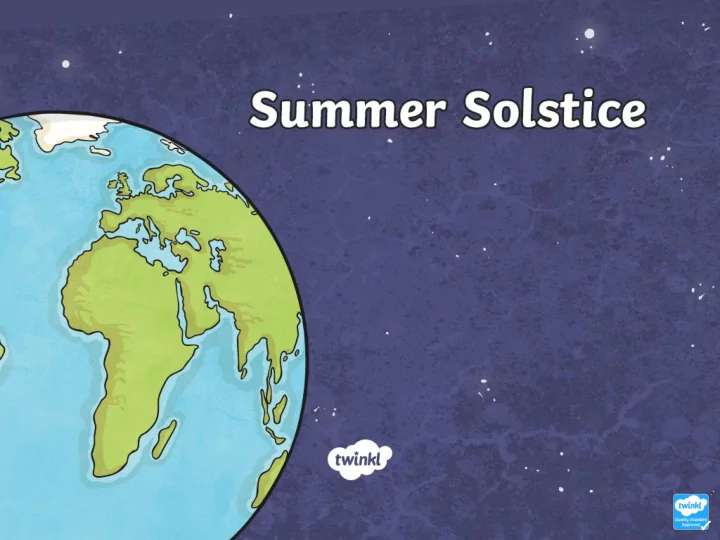

What Is the Summer Solstice? The summer solstice marks the change when the days begin to grow shorter. The winter solstice marks the change when days begin to grow longer. Did You Know…? During the summer, the Arctic is known as Land of the Midnight Sun as there is daylight for 24 hours of the day! Photo courtesy of brizzlebornandbred (@flickr.com) - granted under creative commons licence – attribution
When Is the Summer Solstice? The summer solstice begins around June 21 st . This is also known as the first day of summer and the longest day of the year. On this day, there is the most daylight. On this day, the sun rises around 4:45a.m. and sets around 9:30p.m. This doesn’t mean there are more hours in the day, just that there are more hours of daylight. Photo courtesy of brizzlebornandbred (@flickr.com) - granted under creative commons licence – attribution
Sun Facts The early Egyptians believed that the Sun was a god called Ra. The ultraviolet light in the Sun can cause damage to the eyes and skin, so they need to be protected, even when it doesn’t feel hot. Throughout history, people have told the time by looking at where the Sun was in the sky at different times of the day.
Historic Celebrations Both summer solstice and winter solstice have been celebrated around the world for centuries. People celebrated the summer solstice as they were grateful for the power of the Sun. The Celts celebrated with bonfires that would add to the sun's energy, Christians placed the feast of Saint John the Baptist towards the end of June and it is also the festival of Li, the Chinese Goddess of light. Photo courtesy of Old Leadfoot and (@flickr.com) - granted under creative commons licence – attribution
A Pagan Celebration Solstice, or Litha, means a stopping or standing still of the sun. As the sun spirals its longest dance, Cleanse us As nature shows bounty and fertility Bless us Let all things live with loving intent And to fulfill their truest destiny Wiccan blessing for Summer Photo courtesy of ruraltourism360 (@flickr.com) - granted under creative commons licence – attribution
Pagan Beliefs about the Summer Solstice This is a time to celebrate growth and life. Pagans are very aware of the continuous shifting of the seasons and see this as a time to acknowledge that the Sun will now begin to be less visible towards winter time. Photo courtesy of Jessie Eastland (@wikimedia.com) - granted under creative commons licence – attribution
Summer Solstice at Ancient Sites During the summer solstice, many people gather together at ancient monuments believed to be have spiritual significance, such as Stonehenge. Traditionally, people will aim to see the sunrise and watch the sun align through specific stones. Photo courtesy of Andrew Dunn (@wikimedia.com) - granted under creative commons licence – attribution
Solstice Celebrations around the World Since medieval times in Austria, people have lit mountain bonfires to worship the Earth. In Stockholm, people celebrate midsummer with dancing and singing as on that day the sky never quite darkens due to where Sweden is situated. Photo courtesy of ruraltourism360 (@flickr.com) - granted under creative commons licence – attribution
Summer Solstice Celebrations around the World Some areas of the US hold summer solstice parades in honour of the Sun. Did You Know…? Without the Sun, there would be no life on Earth. Photo courtesy of Joe Mabel (@flickr.com) - granted under creative commons licence – attribution
Recommend
More recommend